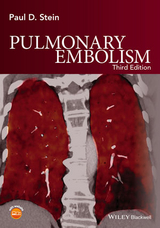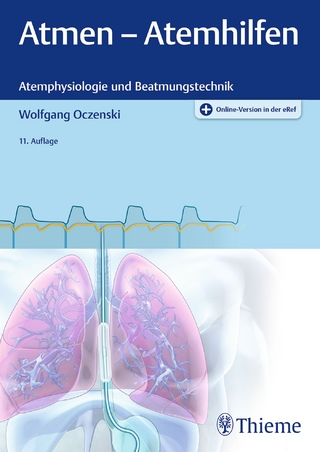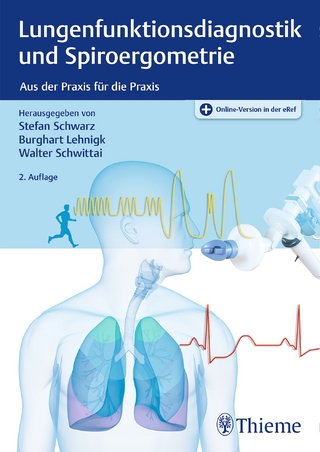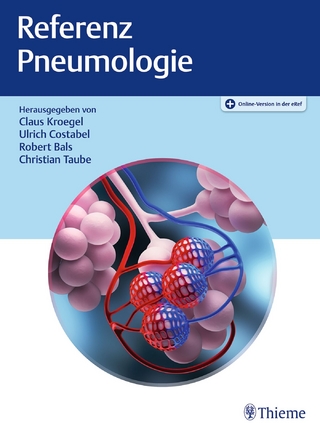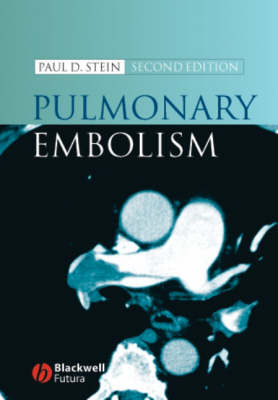
Pulmonary Embolism
Wiley-Blackwell (an imprint of John Wiley & Sons Ltd) (Verlag)
978-1-4051-3807-9 (ISBN)
- Titel erscheint in neuer Auflage
- Artikel merken
"...the best book I've seen on this topic" -- William C. Roberts, MD, Editor in Chief of the American Journal of Cardiology, in a review of the first edition This second edition supplies the latest information on epidemiology, methods of diagnosis, preferred diagnostic pathways, new medications, and new recommendations for prophylaxis and treatment of pulmonary embolism and its immediate cause, deep vein thrombosis. Pulmonary Embolism, Second Edition, incorporates important data from the recent Prospective Investigation of Pulmonary Embolism Diagnosis II (PIOPED II), including: * new clinical observations * accuracy of multidetector computed tomography for the diagnosis of acute pulmonary embolism * recommendations for the use of various imaging tests according to the characteristics of the patient Every chapter of the book has been revised and updated, and 56 new chapters appear in this edition. Through the writing ability of its single author, the text remains as easy to read as it is to consult. This book is a timely reference and a dependable resource for in-depth information about pulmonary embolism.
Dr. Paul D. Stein is on the staff of St. Joseph Mercy-Oakland in Pontiac Michigan. He graduated from the University of Cincinnati College of Arts and Sciences in 1955 with a Bachelors of Science with Honors in Physics and Doctor of Medicine in 1959. Following residencies in internal medicine, he took fellowships in cardiology at the University of Cincinnati under Dr. Noble O. Fowler, Mt. Sinai Hospital in New York (now Mt. Sinai Medical School) under Dr. Charles K. Fiedberg and at Harvard Medical School, Peter Bent Brigham Hospital (now Brigham and Women's Hospital) under Dr. Lewis Dexter. Dr. Dexter was a leader among early investigations of pulmonary embolism. Following fellowship, Dr. Stein became associate director of the cardiac catheterization laboratory at Baylor University Hospital in Dallas, and then he became director of the cardiac catheterization laboratory and assistant professor of medicine at Creighton University. Following that he moved to the University of Oklahoma where he was director of the cardiac catheterization laboratory and eventually Professor of Research Medicine. He moved to Henry Ford Hospital in Detroit in 1976, as Director of Cardiovascular Research, and in 1994 became Medical Director of the Henry Ford Cardiac Wellness Center. He was also Professor of Medicine (Henry Ford Hospital) at Case Western University and Adjunct Professor of Physics at Oakland University. Dr. Stein moved to St. Joseph Mercy-Oakland in August 2000. He is presently Professor of Medicine on the Full Time Affiliate Faculty of Wayne State University. He is also Adjunct Professor of Medical Physics at Oakland University. Dr. Stein's major research in recent years has been in the field of venous thromboembolism. Dr. Stein initiated the PIOPED II national collaborative study and is national principal investigator and chairperson of the steering committee. The first edition of "Pulmonary Embolism" was published in 1996.written over 130 articles on pulmonary embolism from among 460 peer reviewed articles. He is a past president of the Laennec Society and of the American College of Chest Physicians. He is also a Fellow of the American Society of Mechanical Engineers, an honor reserved for those who have made a significant contribution to the field of mechanical engineering. He received the Lifetime Achievement Award from the American Heart Association Midwest Affiliate, the Laureate Award of the American College of Physicians, Michigan Chapter and he is a Master Fellow of the American College of Chest Physicians.
Preface. Part I Prevalence, risks, and prognosis of pulmonary embolism and deep venous thrombosis. 1 Pulmonary embolism and deep venous thrombosis at autopsy. 2 Incidence of pulmonary embolism and deep venous thrombosis in hospitalized patients. 3 Case fatality rate and population mortality rate from pulmonary embolism and deep venous thrombosis. 4 Prognosis in acute pulmonary embolism based on right ventricular enlargement, prognostic models, and biochemical markers. 5 Changing risks of untreated deep venous thrombosis and acute pulmonary embolism. 6 Resolution of pulmonary embolism. 7 Upper extremity deep venous thrombosis. 8 Thromboembolic disease involving the superior vena cava and brachiocephalic veins. 9 Venous thromboembolic disease in the four seasons. 10 Regional differences in the United States of rates of diagnosis of pulmonary embolism and deep venous thrombosis and mortality from pulmonary embolism. 11 Venous thromboembolism in the elderly. 12 Pulmonary thromboembolism in infants and children. 13 Venous thromboembolism in men and women. 14 Comparison of the diagnostic process in black and white patients. 15 Pulmonary thromboembolism in Asians/Pacific Islanders. 16 Pulmonary thromboembolism in American Indians and Alaskan Natives. 17 Venous thromboembolism in patients with cancer. 18 Venous thromboembolism in patients with heart disease. 19 Venous thromboembolism in patients with ischemic and hemorrhagic stroke. 20 Pulmonary embolism and deep venous thrombosis in hospitalized adults with chronic obstructive pulmonary disease. 21 Pulmonary embolism and deep venous thrombosis in hospitalized patients with asthma. 22 Deep venous thrombosis and pulmonary embolism in hospitalized patients with sickle cell disease. 23 Venous thromboembolism in pregnancy. 24 Air travel as a risk for pulmonary embolism and deep venous thrombosis. 25 Estrogen-containing oral contraceptives and venous thromboembolism. 26 Obesity as a risk factor in venous thromboembolism. 27 Hypercoagulable syndrome. Part II Diagnosis of deep venous thrombosis. 28 Deep venous thrombosis of the lower extremities: clinical evaluation. 29 Clinical model for assessment of deep venous thrombosis. 30 Clinical probability score plus single negative ultrasound for exclusion of deep venous thrombosis. 31. D-dimer for the exclusion of acute deep venous thrombosis. 32. D-dimer combined with clinical probability assessment for exclusion of acute deep venous thrombosis. 33. D-dimer and single negative compression ultrasound for exclusion of deep venous thrombosis. 34. Contrast venography. 35. Compression ultrasound for the diagnosis of deep venous thrombosis. 36. Impedance plethysmography and fibrinogen uptake tests for diagnosis of deep venous thrombosis. 37. Computed tomography for diagnosis of deep venous thrombosis. 38. Magnetic resonance angiography for diagnosis of deep venous thrombosis. 39. P-selectin and microparticles to predict deep venous thrombosis. Part III Diagnosis of acute pulmonary embolism. 40. Clinical characteristics of patients with no prior cardiopulmonary disease. 41. Relation of right-sided pressures to clinical characteristics of patients with no prior cardiopulmonary disease. 42. The history and physical examination in all patients irrespective of prior cardiopulmonary disease. 43. Clinical characteristics of patients with acute pulmonary embolism stratified according to their presenting syndromes. 44. Clinical assessment in the critically ill. 45. The electrocardiogram. 46. The plain chest radiograph. 47. Arterial blood gases and the alveolar-arterial oxygen difference in acute pulmonary embolism. 48. Fever in acute pulmonary embolism. 49. Leukocytosis in acute pulmonary embolism. 50. Alveolar dead-space in the diagnosis of pulmonary embolism. 51. Neural network computer-assisted diagnosis. 52. Empirical assessment and clinical models for diagnosis of acute pulmonary embolism. 53. D-dimer for the exclusion of acute pulmonary embolism. 54. D-dimer combined with clinical probability for exclusion of acute pulmonary embolism. 55. D-dimer in combination with amino-terminal pro-B-type natriuretic peptide for exclusion of acute pulmonary embolism. 56. Low tissue plasminogen activator plasma levels and low plasminogen activator inhibitor-1 levels as an aid in exclusion of acute pulmonary embolism. 57. Echocardiogram in the diagnosis and prognosis of acute pulmonary embolism. 58. Trends in the use of diagnostic imaging in patients hospitalized with acute pulmonary embolism. 59. Techniques of perfusion and ventilation imaging. 60. Ventilation-perfusion lung scan criteria for interpretation prior to the Prospective Investigation of Pulmonary Embolism Diagnosis (PIOPED). 61. Observations from PIOPED: ventilation-perfusion lung scans alone and in combination with clinical assessment. 62. Ventilation-perfusion lung scans in patients with a normal chest radiograph, patients with no prior cardiopulmonary disease, patients with any prior cardiopulmonary disease, and patients with chronic obstructive pulmonary disease. 63. Perfusion lung scans alone in acute pulmonary embolism. 64. Probability interpretation of ventilation-perfusion lung scans in relation to largest pulmonary arterial branches in which pulmonary embolism is observed. 65. Revised criteria for evaluation of lung scans recommended by nuclear physicians in PIOPED. 66. Criteria for very low probability interpretation of ventilation-perfusion lung scans. 67. Probability assessment based on the number of mismatched segmental equivalent perfusion defects or number of mismatched vascular defects. 68. Probability assessment based on the number of mismatched vascular defects and stratification according to prior cardiopulmonary disease. 69. The addition of clinical assessment to stratification according to prior cardiopulmonary disease further optimizes the interpretation of ventilation-perfusion lung scans. 70. Single photon emission computed tomographic perfusion lung scan. 71. Standard and augmented techniques in pulmonary angiography. 72 Prevalence of acute pulmonary embolism in central and subsegmental pulmonary arteries. 73. Quantification of pulmonary emboli by conventional and CT angiography. 74. Complications of pulmonary angiography. 75. Contrast-enhanced spiral CT for the diagnosis of acute pulmonary embolism before the Prospective Investigation of Pulmonary Embolism Diagnosis. 76. Methods of PIOPED II. 77. Multidetector spiral CT of the chest for acute pulmonary embolism: results of the PIOPED II trial. 78. Outcome studies of pulmonary embolism versus accuracy. 79. Contrast-induced nephropathy. 80. Radiation exposure and risk. 81. Magnetic resonance angiography for the diagnosis of acute pulmonary embolism. 82. Serial noninvasive leg tests in patients with suspected pulmonary embolism. 83. Predictive value of diagnostic approaches to venous thromboembolism. 84. Diagnostic approaches to acute pulmonary embolism. Part IV Prevention and treatment of deep venous thrombosis and pulmonary embolism. 85. New and old anticoagulants. 86. Prevention of deep venous thrombosis and pulmonary embolism. 87. Treatment of deep venous thrombosis and acute pulmonary embolism. 88. Withholding treatment of patients with acute pulmonary embolism who have a high risk of bleeding provided and negative serial noninvasive leg tests. 89. Thrombolytic therapy in acute pulmonary embolism. 90. Thrombolytic therapy for deep venous thrombosis. 91. Inferior vena cava filters: trends in use, complications, indications, and use of retrievable filters. 92. Catheter-tip embolectomy in the management of acute massive pulmonary embolism. 93. Pulmonary embolectomy. 94. Chronic thromboembolic pulmonary hypertension and pulmonary thromboendarterectomy. Index
| Erscheint lt. Verlag | 22.6.2007 |
|---|---|
| Zusatzinfo | 30 illustrations |
| Verlagsort | Chicester |
| Sprache | englisch |
| Maße | 185 x 258 mm |
| Gewicht | 1362 g |
| Themenwelt | Medizinische Fachgebiete ► Innere Medizin ► Pneumologie |
| ISBN-10 | 1-4051-3807-6 / 1405138076 |
| ISBN-13 | 978-1-4051-3807-9 / 9781405138079 |
| Zustand | Neuware |
| Haben Sie eine Frage zum Produkt? |
aus dem Bereich
